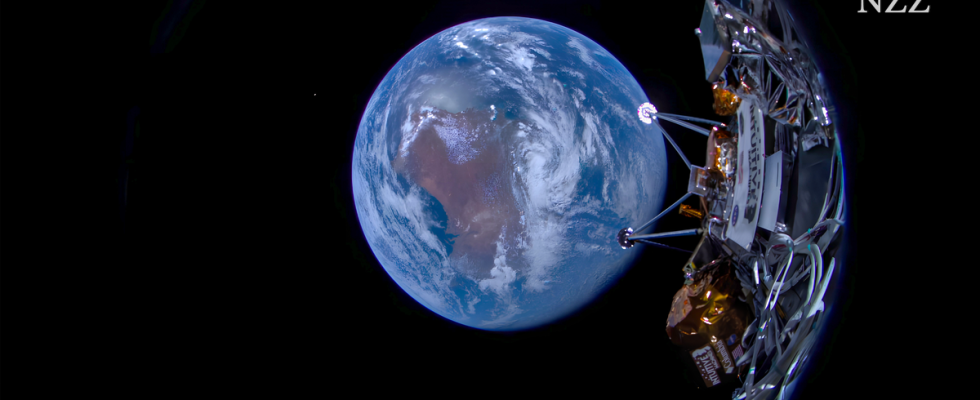Exploration of the Moon began with a hard impact in the 1950s. Since then, probes have repeatedly crashed. Why is that?
A selfie shows the lunar lander Odysseus with the Earth in the background. The picture was taken shortly after separation from the rocket.
Landing gently on the moon is no child’s play. This bears witness a long list of probes that never reached the moon or crashed on it. Even state space organizations with decades of experience are not immune to setbacks. In August last year, the Russian lunar probe Luna-25 crashed into a lunar crater.
On February 22nd, the moon will be in focus again. On this day, the American space company Intuitive Machines attempts to safely land its unmanned Odysseus lander in the south polar region of the moon.
Success would be a milestone for various reasons. It would be the first time in more than 50 years that an American probe landed on the moon. And it would be the first time ever that a private company has achieved this feat.
The Odysseus lander survives takeoff
Intuitive Machines has already overcome the first obstacle. The Odysseus lander was launched into space on February 15 on a Space X rocket. He separated from the rocket about an hour after launch. According to the manufacturer The orientation of the probe was stable, the solar cells produced electricity, and communication with the control center also worked perfectly.
The Odysseus lunar lander is about the size of a telephone booth.
This means that Intuitive Machines is already one step further than the American company Astrobotic Technology. Their lunar lander reached space in January, but then lost fuel due to a leak. The lander began to tumble and could no longer be aimed at the sun. Under these circumstances, a soft landing on the moon was impossible. The company decided to let the lander burn up in Earth’s atmosphere.
The failure draws attention to the most important component of a lunar lander: its propulsion system. One of the biggest differences between the moon and the planets in the solar system is that the moon has no atmosphere. Without air resistance, a lunar probe cannot be slowed down with parachutes. Instead, the engines are used to reduce the speed – from typically 6,000 kilometers per hour to almost zero.
This not only requires sophisticated engines whose thrust can be changed, but also economical use of fuel. This is only available in limited quantities. If the probe loses too much fuel on the way to the moon, it will be missing when it lands.
A Japanese lander runs out of fuel
This was the undoing of the Hakuto-R lander from the Japanese space company Ispace in April last year. A defective altimeter suggested that the lander had already landed. In fact, it was still five kilometers above the lunar surface. The lander ran out of fuel in the last few kilometers. It went into free fall and hit the moon at a speed of 550 kilometers per hour.
Even with enough fuel, there are plenty of things that can go wrong during a moon landing. The Israeli Beresheet mission failed in 2019 due to a defective acceleration sensor. The operations team in the control center tried to reactivate the sensor, but this triggered a chain reaction that ultimately led to the engines automatically shutting down. How a later analysis showed, the probe crashed into the moon at a speed of 3,000 kilometers per hour, leaving a small crater behind.
A moon landing is made even more difficult by the dust that the engines kick up. Unlike earthly dust, moon dust has sharp edges. There is therefore a risk that a lander’s sensitive sensors will be damaged. In addition, the dust raised can impair visibility, meaning that the sensors may misjudge the distance to the lunar surface.
Without functioning sensors, a moon landing becomes a suicide mission. The probe has to decide largely autonomously where and when it will land based on the sensor data. This cannot be controlled from Earth. A radio signal takes more than two seconds to travel from the moon to the earth and back. If an unforeseen obstacle appeared on the lunar surface during this time, the order to avoid it would come too late.
Without private people, the colonization of the moon cannot succeed
The long list of failures shows that even experienced spacefaring nations can fail when faced with these challenges. The risk is even greater for private companies that are still new to the space business. Unlike the state-sponsored space agencies, they have to spend every cent if they want to be commercially successful. This means that they have to make certain compromises in technology and when testing components, which reduce their chances of success.
On the other hand, this cost awareness is also one of the reasons why private companies play an important role in developing the moon. If the USA, China and other spacefaring nations are serious about establishing themselves permanently on the moon, they will need a lot of supply flights.
NASA decided a few years ago to put this task in private hands. As part of the Commercial Lunar Payload Services (CLPS) program, it awards contracts to companies that bring equipment and scientific instruments to the moon. NASA is paying Intuitive Machines $118 million to transport six payloads. Astrobotic Technology received a similar amount. The Odysseus lander also transports other payloads, such as a sculpture by the artist Jeff Koons.
Relying on private companies poses a financial risk for NASA. The initiator of the CLPS program, former NASA science director Thomas Zurbuchen, publicly stated that he expected every second mission to fail. If that turns out to be true, NASA would still get off cheaply. If it were to develop the lunar landers on its own, it would cost between $500 million and $1 billion per mission. Paying just to transport the payloads is clearly cheaper for NASA.

